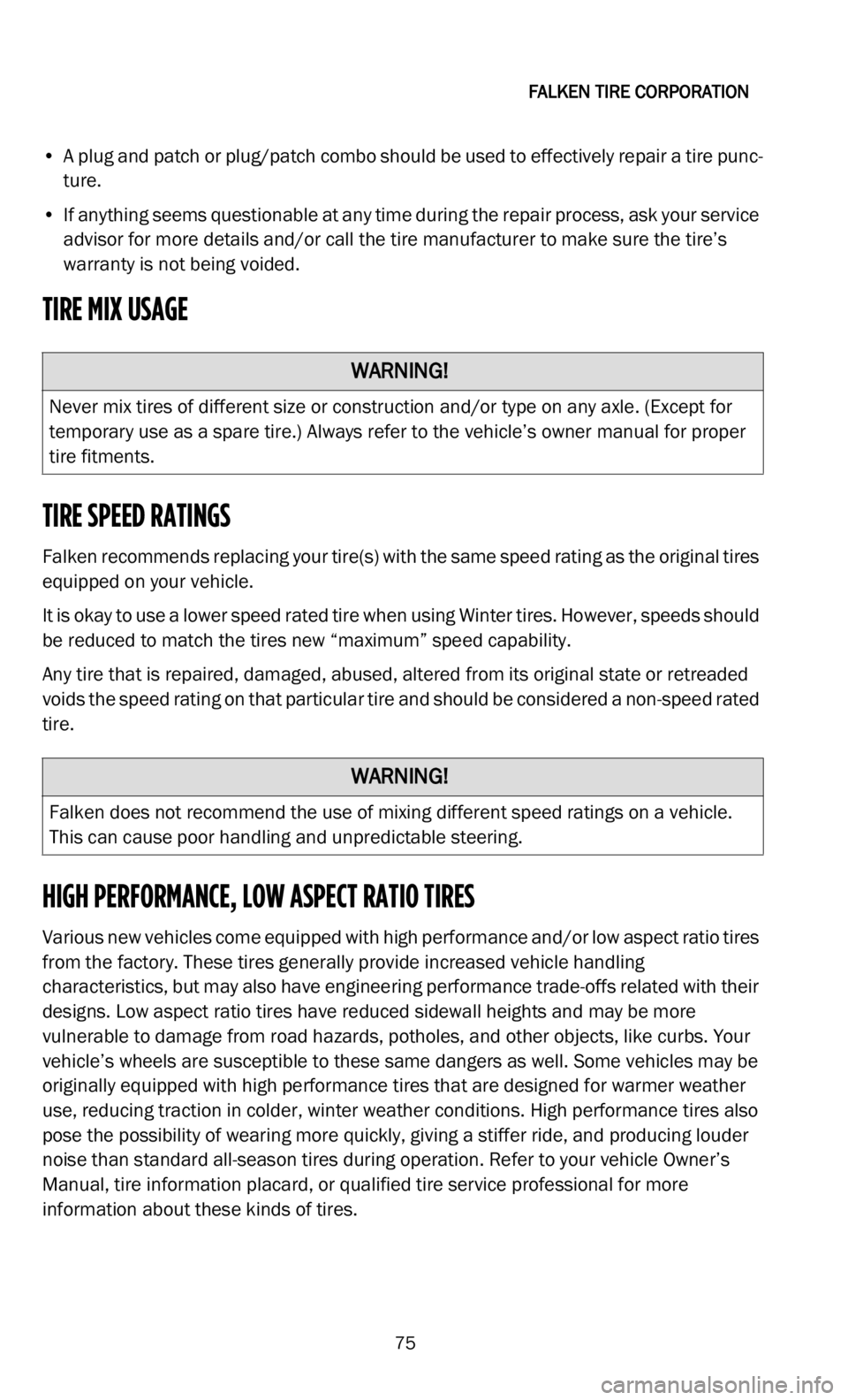height DODGE DURANGO 2022 Vehicle Warranty
[x] Cancel search | Manufacturer: DODGE, Model Year: 2022, Model line: DURANGO, Model: DODGE DURANGO 2022Pages: 200, PDF Size: 6.72 MB
Page 4 of 200

TIRES
3
Tire Sizing Chart
EXAMPLE:
Example Size Designation: P215/65R15XL 95H, 215/65R15 96H, LT235/85R16C,
T1 4
5/80D18 103M, 31x10.5 R15 LT
P = Passenger car tire size based on US design standards, or
"....blank...." =
Passenger car tire based on European design standards, or
LT = Light Truck tire based on US design standards, or
T
or S = Temporary spare tire or
3 1 =
Overall diameter in inches (in)
2 1
5, 235, 145 =
Section width in millimeters (mm)
65, 85, 80 = Aspect ratio in percent (%)
• Ra
tio of section height to section width of tire, or 10
.5 = Section width in inches (in)
R = Construction code
• "R" means radial construction, or
• "D
" means diagonal or bias construction
1 5
, 16, 18 = Rim diameter in inches (in)
S e
rvice Description:
95 = Load Index
• A
numerical code associated with the maximum load a tire can carry
H
= Speed Symbol
• A symbol indicating the range of speeds at which a tire can carry a load corre -
s p
onding to its load index under certain operating conditions
• The maximum speed corresponding to the speed symbol should only be achieved un
der specified operating conditions (i.e., tire pressure, vehicle loading, road condi -
tions, and posted speed limits)
Load Identification:
Absence of the following load identification symbols on the sidewall of the tire
in d
icates a Standard Load (SL) tire:
• XL = Extra load (or reinforced) tire, or
• LL =
Light load tire or
• C, D, E, F, G =
Load range associated with the maximum load a tire can carry at a
specified pressure
Maximum Load –
Maximum load indicates the maximum load this tire is designed to
carry
Maximum Pressure –
Maximum pressure indicates the maximum permissible cold tire
inflation pressure for this tire
Page 48 of 200

BRIDGESTONE® - FIRESTONE®
47
This manual is not intended to provide proper training or service procedures for tire
mounting, demounting, balancing, rotation, or repair. Please leave these tasks to
qualified tire service professionals. For your safety and that of others:
• A lways stand well clear of any tire mounting operation. This is especially important
w
hen the service operator inflates the tire. If the tire has been improperly mounted, it
may burst with explosive force causing serious personal injury or death.
• T ires must match the width and diameter requirements of the wheels. For example,
1
6 inch diameter tires must only be mounted to 16 inch diameter wheels. Radial tires
m u
st only be mounted to wheels approved for radial tires.
• W heels must be free of cracks, dents, chips, and rust. Tires must be free of bead
d
amage, cuts, and punctures.
• N ever inflate a tire beyond 40 psi (275 kPa) to seat the beads. Be absolutely certain
b
eads are fully seated before adjusting inflation pressure to the level recommended
for vehicle operation.
• N ever put flammable substances in tire/wheel assemblies at any time. Never put any
f
lammable substance into a tire/wheel assembly and attempt to ignite to seat the
beads.
• A lways stand well away from the work area when tires are being spin balanced either
o
n or off the vehicle.
HIGH PERFORMANCE, LOW ASPECT RATIO TIRES
Many new vehicles come equipped from the factory with high performance and/or low
aspect ratio tires. Generally, these tires provide increased vehicle handling capability,
but may also have numerous engineering performance trade-offs associated with their
designs.
• Lo w aspect ratio tires, with reduced sidewall height, may be more susceptible to
d
amage from potholes, road hazards, and other objects such as curbs. This is true for
the wheels as well. Therefore, as with all other tires, it is important to drive with care
and maintain proper inflation pressure and load conditions. See “Tire Inflation Pres -
sure” and “Tire Damage, Inspection and Service Life” in this manual.
• Some sports cars and other handling performance enhanced vehicles, including s
edans and light trucks/SUVs, may be originally equipped with high performance tires
that are more optimized for warmer weather use. Colder, winter weather traction may
be reduced for these types of tires. Winter tires may be recommended by the vehicle
manufacturer for colder weather application. See “Winter Tires,” the next section in
this manual.
• H igh performance tires may also wear more quickly, ride more firmly, and produce
m
ore noise during operation.
Consult your vehicle Owner’s Manual and tire information placard, or a qualified tire
s e
rvice professional, for more information and specifics regarding these types of tires.
Page 76 of 200

FALKEN TIRE CORPORATION
75
• A plug and patch or plug/patch combo should be used to effectively repair a tire punc -
ture.
• I f anything seems questionable at any time during the repair process, ask your service
a
dvisor for more details and/or call the tire manufacturer to make sure the tire’s
warranty is not being voided.
TIRE MIX USAGE
TIRE SPEED RATINGS
Falken recommends replacing your tire(s) with the same speed rating as the original tires
equipped on your vehicle.
It is okay to use a lower speed rated tire when using Winter tires. However, speeds should
b e
reduced to match the tires new “maximum” speed capability.
Any tire that is repaired, damaged, abused, altered from its original state or retreaded
v o
ids the speed rating on that particular tire and should be considered a non-speed rated
tire.
HIGH PERFORMANCE, LOW ASPECT RATIO TIRES
Various new vehicles come equipped with high performance and/or low aspect ratio tires
from the factory. These tires generally provide increased vehicle handling
characteristics, but may also have engineering performance trade-offs related with their
designs. Low aspect ratio tires have reduced sidewall heights and may be more
vulnerable to damage from road hazards, potholes, and other objects, like curbs. Your
vehicle’s wheels are susceptible to these same dangers as well. Some vehicles may be
originally equipped with high performance tires that are designed for warmer weather
use, reducing traction in colder, winter weather conditions. High performance tires also
pose the possibility of wearing more quickly, giving a stiffer ride, and producing louder
noise than standard all-season tires during operation. Refer to your vehicle Owner’s
Manual, tire information placard, or qualified tire service professional for more
information about these kinds of tires.
WARNING!
Never mix tires of different size or construction and/or type on any axle. (Except for
temporary use as a spare tire.) Always refer to the vehicle’s owner manual for proper
tire fitments.
WARNING!
Falken does not recommend the use of mixing different speed ratings on a vehicle.
This can cause poor handling and unpredictable steering.